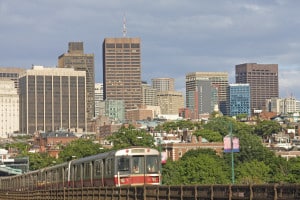Transit access has for some years meant Greater Boston home sellers and commercial landlords alike could demand a premium for their property, but a new study from the National Association of Realtors and the American Public Transportation Association (APTA) has quantified just how much as the area’s roadways began their slow descent into sclerosis.
The study also revealed bus rapid transit networks in other large cities, which many transit advocates say represent Boston’s best hope of quickly addressing congestion alongside “congestion pricing” on highways, had strong benefits to the sale prices of homes and commercial properties sold within a half-mile of their stops.
The study covered a period from 2012 to 2016, in which 30 percent of Boston-area workers who lived within a half-mile of transit commuted by public transportation as compared with 12 percent for the region. Of those residents in this “transit shed,” 16 percent walked or biked to work, compared with 7 percent region-wide. In total, 1.02 million people in 402,205 households lived within a half-mile of transit during the time period under study, representing 21.7 percent of the total area’s population and 22.6 percent of all households.
Residential sale properties within a half-mile of the MBTA’s commuter rail, subway and Silver Line stops saw median sale prices grow by 29 percent between 2012 and 2016, fully 9 percent higher than median residential sale prices in the metro as a whole.
Overall, home prices near the Concord commuter rail station and the East Boston neighborhood of Jeffries Point saw the biggest gains among transit-accessible areas. In both station areas, median sales prices went
up by 144 percent, almost five times the increase in median price in all areas within a half-mile of transit. The MBTA’s Red, Orange and Blue lines provided the best value, the NAR study found, noting that the commuter rail still helped improve home sale prices faster than the regional median.
Commercial properties sold in the MBTA’s transit shed also were able to command higher prices over the same time period, albeit at a lower spread from transit inaccessible ones. However, while sale prices of transit-accessible commercial assets grew by 25 percent compared to 21 percent for the region overall, office properties near transit saw their value increase substantially. Offices sold within a half-mile of a transit stop saw their price jump 38 percent from 2012 to 2016, compared to a region-wide increase in sale prices of just 3 percent.
Small offices saw the biggest benefit to their sale price from being close to transit, NAR found. The median sale price for medium-sized offices, which the study noted were likely occupied by companies moving into the urban core, performed 10 times better in the transit shed compared to similar properties region-wide.
Transit did not appear to have an impact on the median sale price of retail properties, which increased at the same rate as retail properties region-wide, and smaller retail properties actually saw slower growth in their median per-square-foot sale price within the transit shed than the regional median. However, the study suggested this could be because many of these properties were in the urban core, where rental pricing and vacancy rates are most competitive.
“Access to public transportation is an extremely valuable community amenity that increases the functionality and attractiveness of neighborhoods, making nearby communities more desirable places to live, work and raise a family,” NAR 2019 First Vice President Charlie Oppler said in a statement. “The results of our report, conducted over multiple years alongside the American Public Transportation Association, should reiterate to policymakers at all levels of government the importance of investing in modern, efficient infrastructure that facilitates growth and helps our nation keep pace in a rapidly evolving world.”
The study examined Boston and six other cities – Hartford; Los Angeles; Minneapolis-St. Paul; Phoenix; Seattle; and Eugene, OR – as a proxy for how commuter rail, subways, light rail and bus rapid transit affect sale prices nation-wide. Residential properties within these areas had 4 percent to 24 percent higher median sale prices between 2012 and 2016, the report found. Commercial property near public transit also witnessed value gains in the studied cities, where four of the regions saw median sales prices per square foot increase between 5 percent to 42 percent.
Many of those cities saw their gains come from expansions of their bus rapid transit networks, lines where buses were given dedicated lanes for all or part of their routes, priority at traffic signals, where stops were consolidated and amenities improved at the remaining stops.
- In Hartford, the median home sale prices near the new CTfastrak line performed better than the nontransit areas between 2012 and 2016, a 13 percent increase compared to a 3 percent increase for prices region-wide. Commercial properties saw a bigger boost, with the median sale price growing 16 percent in the transit shed compared to 2 percent region-wide.
- In Los Angeles, bus rapid transit stops grew nearby commercial sale prices by 157 percent compared to 55 percent median price growth in non-transit areas.
- In Eugene, bus rapid transit stops grew the median home sale price near transit stops by 49 percent, compared to a 25 percent increase in non-transit areas.
“Public transit’s benefits go beyond moving people from point A to point B,” APTA President and CEO Paul P. Skoutelas said in a statement. “Public transportation is a valuable investment in our communities, our businesses, and our country. Public transportation gets people to jobs and educational opportunities and helps businesses attract employees and customers.”







